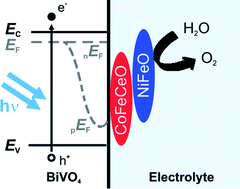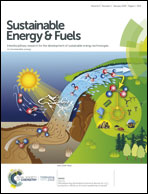Interface engineering for light-driven water oxidation: unravelling the passivating and catalytic mechanism in BiVO4 overlayers†
Abstract
Artificial photosynthetic approaches require the combination of light absorbers interfaced with overlayers that enhance charge transport and collection to perform catalytic reactions. Despite numerous efforts that have coupled various catalysts to light absorbing semiconductors, the optimization of semiconductor/catalyst as well as catalyst/electrolyte interfaces and the identification of the role of the catalyst still remain a key challenge. Herein, we assemble (NiFeCoCe)Ox multi-component overlayers, interfaced with bismuth vanadate photoanodes, and determine the roles of different elements on promoting interfacial charge transfer and catalytic reaction over competitive photocarrier recombination loss processes. Through this understanding, and aided by complementary macroscopic photoelectrochemical measurements and nanoscale atomic force microscopy techniques, a bifunctional (CoFeCe/NiFe)Ox overlayer was rationally engineered. The resulting multi-functional coating yields BiVO4 photoanodes with almost 100% efficient surface collection of holes under oxygen evolving reaction conditions. The (CoFeCe)Ox component excels at efficient capture and transport of photogenerated holes in BiVO4 through the availability of redox active states, whereas (NiFe)Ox plays a vital role in reducing charge recombination at the BiVO4/electrolyte interface. In addition, this study supports the hypothesis that catalytic sites act as electronically active trap states on uncoated BiVO4 photoanodes.



 Please wait while we load your content...
Please wait while we load your content...